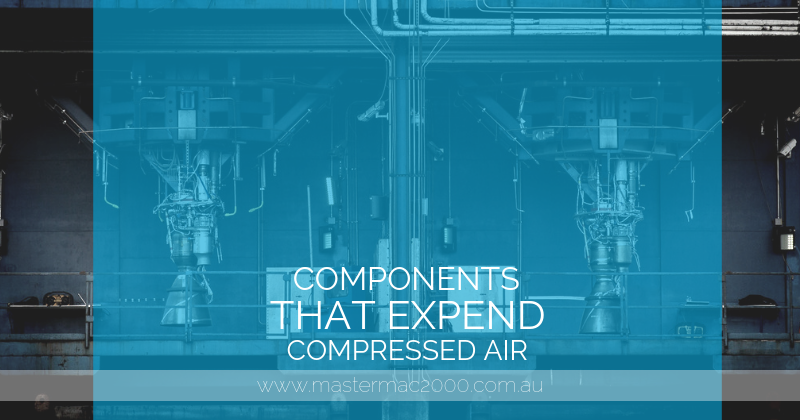Components that expend compressed air

Assistant valves, directional control valves, and execution valves (cylinders) are the components that consume compressed air. Let us identify each of them.
Control valve
Control valves are valves that control air flow. Such valves include flow pressure control valve, non-return valves, shuttle valves, and more.
Flow-control valve. Formed by a variable throttle and a non-return valve.
Non-return valve. Also called poppet valve, non-return valve allows the flow of air in one direction only. It closes when air flows in the opposite direction.
Shuttle valve. Called single control or double control non-return valves, shuttle valves have air inlets and an air outlet.
Directional control valve
What ensures the flow of air between air ports by switching, opening, and closing their internal connections are directional control valves. They are classified through determining the number of ports and switching positions, the valve’s methods of operation, and its normal position.
2/2 Directional control valve. It’s the valve with the simplest structure. To open and close the valve, it uses the thrust from the spring. This stops compressed air from flowing en route to the working tube from the air inlet. The pressure control valve can be driven either mechanically or manually.
3/2 Directional control valve. This valve can be used in controlling single acting cylinders. How does it work? The open valves located in the middle will close until the inlet and the working tube are connected together. They can be driven pneumatically, manually, mechanically, or electrically.
5/2 Directional control valve. In this type of valve, the pressure pulse is fed into the pressure control port inlet to move the spool to the left, connecting the inlet and the work passage. The work passage will then release air through the air exhausts. Until signals of the contrary are received, the directional valves will remain in this specific operational position.
Execution component
This type of component provides rotary motion, the movement provided by pneumatic motors, or rectilinear movement, the movement produced by cylinder pistons. Cylinders come with different kinds including single acting and double acting cylinders.
Single acting cylinder. It’s the kind of cylinder that has only one entrance where compressed air is allowed to flow through. The piston rod is pushed in the opposite direction by a spring inside or by the external force brought about by weight of a load or mechanical movement.
Directional acting cylinder. In double acting cylinders, air pressure is worked alternately to the surface parallel to the piston. They produce a drawing force or a propelling force. And since the piston’s effective area is small, the force generated during retraction is rather weak.
To learn more about this topic, contact us at Mastermac2000.com.au.

About MasterMac2000: Your Trusted Pneumatic & Process Automation Partner.
LEADING THE INDUSTRY: Established in 1989, MasterMac2000 has grown to become one of Australia's largest privately owned pneumatic and process automation companies. We stock top-quality brands like Univer, Mack, Tolomatic, Mac, Piab, American, and Rotoflux in Brisbane.
SERVING QLD & NORTHERN NSW: We proudly service Queensland and Northern New South Wales for all your pneumatic and process equipment needs. Our mission is to provide the best pre and post-sales support while actively expanding our client base.
SOURCING HARD-TO-FIND PARTS: Not only do we stock quality components, but we also excel at sourcing those elusive, hard-to-find parts. With our extensive database and global network of contacts, getting the parts you require is as easy as a call to our highly skilled, professional sales team.
DEDICATED TO YOUR SUCCESS:
- Decades of expertise in pneumatics & process automation
- Carefully curated selection of world-class brands
- Exceptional sourcing capabilities for speciality parts
- Knowledgeable sales staff dedicated to finding solutions
- Unwavering commitment to customer service excellence
About The Author
Stuart Havill
Stuart Havill is the owner and manager of MasterMac2000, Queensland's largest privately owned pneumatic and process valve company.
With his early working career as a maintenance fitter for Boral in 1992, Stuart has spent his life in the field of pneumatics and process equipment. He gained extensive experience in plant design, maintenance, repairs, fabrication, and site management.
In 1996, he transitioned to a pneumatic sales technician role at MasterMac2000, where he excelled in key account management, providing cost-effective solutions, and managing a sales team of 9 employees.
Since 2002, Stuart has been the manager at MasterMac2000, overseeing the company's growth and establishing it as a leader in pneumatic automation and process valve engineering. His expertise spans customer training, CRM setup, industrial compressor sizing and installation, and turn-key project management.
Under Stuart's leadership, MasterMac2000 has been servicing the industry since 1988, with 5 full-time sales representatives covering northern rivers NSW, Queensland, Northern Territory, and PNG. The company prides itself on providing the best-priced solutions to all customers in the marketplace.
View Stuart’s LinkedIn profile to learn more about his expertise in pneumatics and process equipment.